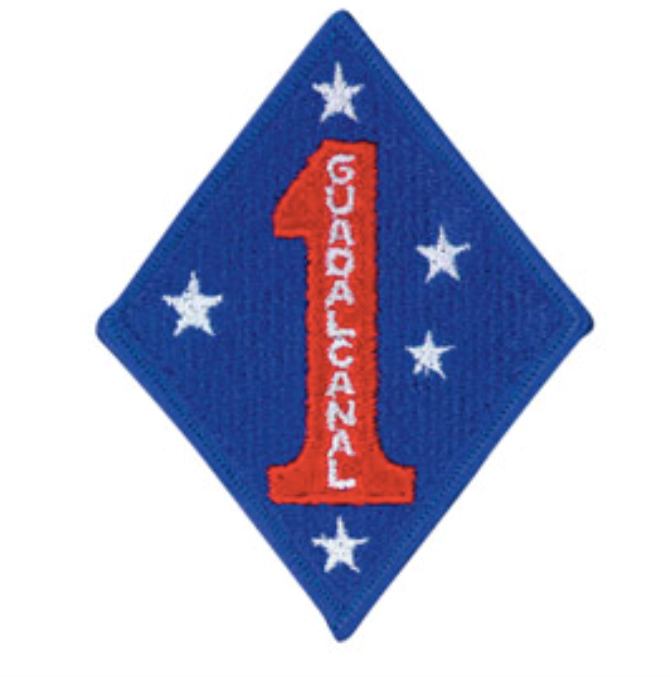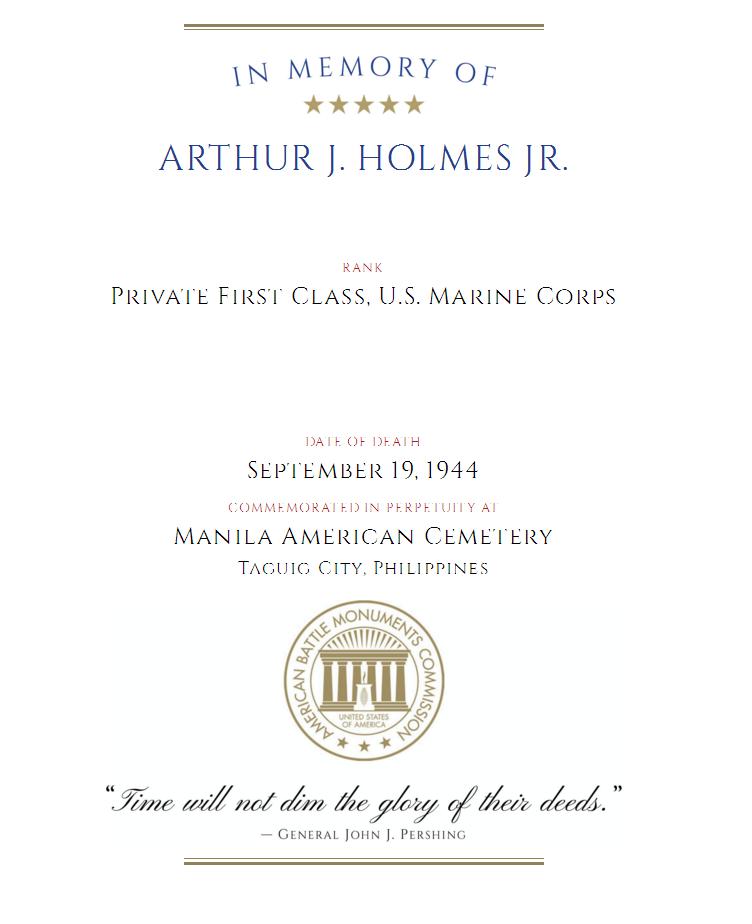Arthur Joseph Holmes (December 11, 1923–September 19, 1944)
by Sebastian Giraldo and Rachel Street
Pre-Service
Arthur Joseph Holmes was born in New York on December 11, 1923, to Arthur and Josephine Holmes.1 One of three children, Holmes lived in Manhattan, New York City, with his parents and younger siblings Eugene and Elizabeth throughout his childhood.2 Sometime around 1940, Holmes began work as an errand boy, while his mother worked as a clerk.3 According to the 1940 census, Holmes’ father did not live with the family at the time. As a result, it is likely that Arthur worked to help support his mother and two younger siblings.4
Service
Holmes enlisted in the US Marine Corps on January 26, 1942, in New York, roughly one month after the US entered World War II.5 After enlistment, Holmes traveled to Parris Island, South Carolina.6 In World War II, Parris Island served as a Marine Corp recruiting depot that trained over 200,000 soldiers during the span of the conflict.7 Marine Corps recruit training lasted between seven and eight weeks.8 After completing training, Holmes was assigned to a Marine battalion.
By April of 1942, Holmes joined Company C, First Battalion, First Marines, First Marine Division, Fleet Marine Force, an infantry division stationed in New River, North Carolina, at the time.9 Designated for the Marine First Division during World War II, the patch worn by members of the 1st Division commemorated participation in the Battle of Guadalcanal with the stars on the patch representing the Southern Cross constellation, which would have appeared in the sky above where the fighting occurred.10 Three months later Holmes’ company shipped out to Wellington, New Zealand, on the USS Barnett and arrived on July 11, 1942.11 In October, the company performed duties in the Guadalcanal war zone and engaged in the Battle of Tenaru.12 The Battle of Tenaru on August 21, 1942 marked the first Japanese counter-attack in the area and led to one of the heaviest fighting days in the war for the 1st Marine Regiment.13 Between forty-one and forty-three marines from the 1st Marine Regiment lost their lives in the fighting, but the biggest obstacle for the regiment was fighting disease. By December, 8,580 men from the 1st Marine Division were hospitalized for malaria.14
In January of 1943, Holmes and his company embarked for Camp Murphy in Melbourne, Australia, aboard the USS American Legion where they rested after the trials they faced in battle.15 But, for Holmes, the journey did not end there. Seven months later, Holmes transferred to Company E, Second Battalion, First Marines, First Marine Division, Fleet Marine Force in July of 1943, stationed at Camp Rowville in Dandenong, Victoria, Australia.16 In September 1943, the Second Battalion participated with the Australian 9th Division in the early phases of the Huon Peninsula campaign, aimed to push the Japanese out of Papua New Guinea.17 The Second Battalion fought alongside the Australians until December 1943.18
Then in January of 1944, Company E re-engaged enemy troops at Camp Gloucester, New Britain, and also served as the rear echelon at Goodenough Island in Australia.19 The actions during this period were a part of Operation Cartwheel to attack the Japanese base at Rabaul.20 During the Battle of Cape Gloucester, which occurred in the midst of the operation, it was the 1st Marine Division that first reached the shore.21
Three months later, the company embarked for the Pavuvu Islands, part of the British Solomon Islands, aboard the USS President Adams.22 From September to December of 1944, Second Battalion troops joined the occupation of the southern Palau Islands as a part of the Battle of Peleliu.23 Beginning in early September with the objective to capture a Japanese air strip, the battle—later dubbed “the bitterest battle of the war,”—lasted until November 27, 1944.24 Of the the 13,000 Japanese troops who fought in the battle, little over 200 survived.25 Although smaller in numbers, the Japanese inflicted heavy casualties. The 1st Marine Division suffered fifty-six percent casualties within the first ten days of battle and 1,749 soldiers died during the battle.26 Private First Class Holmes was one of those who lost his life while fighting on September 14, 1944.27 After Holmes’ death, his division went on to fight in the Battle of Okinawa.28 Holmes was buried at sea and memorialized in the Manila American Cemetery in the Philippines. 29
Here his name can be found on the “Walls of the Missing,” located at the Manila American Cemetery in Taguig, Philippines. These walls contain the names of 36,286 service members. Holmes’ name is amongst his comrades, whose remains were never identified or buried at sea.30
Holmes’ actions during the war earned him a Bronze Star and Purple Heart Medal.31 If Holmes had participated in any war earlier than World War II, he would not have been eligible for the Purple Heart Medal. The medal was only available to army service members until President Franklin D. Roosevelt issued Executive Order 9277 in December of 1942, which opened up eligibility to all branches of service.32 At the time Holmes received the Purple Heart, the requirements were that the service member had to be “wounded in action against an enemy of the United States, or as a result of an act of such enemy, provided that such would necessitate treatment by a medical officer.”33 While we do not know exactly what role Holmes played in the war, he exemplified bravery in battle. In order to earn a Bronze Star Medal, a soldier “distinguishes himself after December 6, 1941 by heroic or meritorious achievement or service, not involving participation in aerial flight.”34 PFC Holmes is memorialized for his service to this country at the Florida National Cemetery in Bushnell, Florida.35
Endnotes
1 “1930 United States Federal Census,” database, Ancestry.com, http://www.ancestry.com (accessed July 31, 2017), entry for Arthur Holmes, Enumeration District Number 31-700, Sheet Number 16A-16B.
2 Ibid.; “1940 United States Federal Census,” database, Ancestry.com, http://www.ancestry.com (accessed July 31, 2017), entry for Josephine Holmes, ED 31-1452.
3 Ibid.
4 Ibid.
5 ”U.S. Veterans Gravesites, ca.1775-2006,” database, Ancestry.com, http://www.ancestry.com (accessed July 31, 2017), entry for Arthur J. Holmes.
6 “U.S. Marine Corp Muster Rolls, 1798-1958,” database, Ancestry.com, http://www.ancestry.com (accessed July 31, 2017), entry for Arthur J. Holmes, Headquarters, Eastern Recruiting Division, 1700 Sanson Street, Philadelphia, PA, Jan 1-31, 1942.
7 “History of Parris Island,” United States Marine Corp, accessed July 31, 2017, http://www.mcrdpi.marines.mil/About/History-of-Parris-Island/.
8 Ibid.; Michael E. Haskew, The Marines in World War II (New York: Thomas Dunn Books, 2016), 8. At one point, the influx of recruits led to shortened training programs of one month because the depot could not accommodate the large number of incoming soldiers, but this was found to be inadequate.
9 “U.S. Marine Corp Muster Rolls, 1798-1958,” database, Ancestry.com, http://www.ancestry.com (accessed July 31, 2017), entry for Arthur J. Holmes, Company “C”, First Battalion, First Marines, First Marine Division, Fleet Marine Force, Marine Barracks, New River, North Carolina, April 1-30, 1942.
10 “1st Marine Division:Insignia,”United States Marine Corp, accessed July 31, 2017, http://www.1stmardiv.marines.mil/About/Insignia/.
11 “U.S. Marine Corp Muster Rolls, 1798-1958,” database, Ancestry.com, http://www.ancestry.com (accessed July 31, 2017), entry for Arthur J. Holmes, Company “C”, First Battalion, First Marines, First Marine Division, Fleet Marine Force, ℅ Postmaster San Francisco, California, July 1-31, 1942.
12 “U.S. Marine Corp Muster Rolls, 1798-1958,” database, Ancestry.com, http://www.ancestry.com (accessed July 31, 2017), entry for Arthur J. Holmes, Co “C”, 1st BN, 1st Mar, FMD, FMF, ℅ F.P.O. San Francisco, California, Oct. 1-31, 1942.
13 “1st Marine Division History,” United States Marine Corp, accessed July 31, 2017, http://www.1stmardiv.marines.mil/Units/1ST-MARINE-REGT/History/.
14 Allan R Millett, Peter Maslowski, and William B. Feis, For the Common Defense: A Military History of the United States from 1607 to 2012 (New York: Free Press, 2012), 397; Michael T. Smith, Bloody Ridge: The Battle that Saved Guadelcanal (New York, Pocket, 2000), 71, 259-60.
15 “U.S. Marine Corp Muster Rolls, 1798-1958,” database, Ancestry.com, http://www.ancestry.com (accessed July 31, 2017), entry for Arthur J. Holmes, Co “C”, 1st BN, 1st Mar, FMD, FMF, ℅ F.P.O. San Francisco, California, Jan. 1-31, 1943.; “1st Marine Division History,” United States Marine Corp.
16 “U.S. Marine Corp Muster Rolls, 1798-1958,” database, Ancestry.com, http://www.ancestry.com (accessed July 31, 2017), entry for Arthur J. Holmes, Co “C”, 1st BN, 1st Mar, FMD, FMF, ℅ F.P.O. San Francisco, California, July. 1-31, 1943.; “U.S. Marine Corp Muster Rolls, 1798-1958,” database, Ancestry.com, http://www.ancestry.com (accessed July 31, 2017), entry for Arthur J. Holmes, Second Battalion, First Marines, First Marine Division, Fleet Marine Force, ℅ Postmaster San Francisco, California, July 1-31, 1943.
17 “2nd Battalion, 1st Marines, 1st Marine Division, United States Marine Corp, accessed July 31, 2017, http://www.1stmardiv.marines.mil/Units/1ST-MARINE-REGT/2nd-Battalion/History/.
18 David Horner, “Strategy and Generalship: Strategic and Operational Planning for the 1943 Offensives,” in The Foundations of Victory: The Pacific War 1943-1944, Peter Dennis and Jeffrey Grey, eds.(Canberra, Australian: Army History Unit, 2004), 31.
19 “U.S. Marine Corp Muster Rolls, 1798-1958,” database, Ancestry.com, http://www.ancestry.com (accessed July 31, 2017), entry for Arthur J. Holmes, Second Battalion, 1st Mar, FMD, FMF, ℅ F.P.O. San Francisco, California, Jan. 1-31, 1944.
20 “1st Marine Division History,” United States Marine Corp.; Millett, For the Common Defense, 397.
21 Ibid.
22 “U.S. Marine Corp Muster Rolls, 1798-1958,” database, Ancestry.com, http://www.ancestry.com (accessed July 31, 2017), entry for Arthur J. Holmes, Second Battalion, 1st Mar, FMD, FMF, ℅ F.P.O. San Francisco, California, April. 1-30, 1944.
23 Ibid.
24 Cpl. Drew Tech, “Marines Remember Battle of Peleliu During 70th Anniversary,” United States Marine Corp, Oct. 3, 2014, accessed July 31, 2017, http://www.marines.mil/News/News-Display/Article/503257/marines-remember-battle-of-peleliu-during-70th-anniversary/.
25 Ibid.
26“1st Marine Division History,” United States Marine Corp.
27 “World War II and Korean Conflict Veterans Interred Overseas,” database, Ancestry.com, http://www.ancestry.com (accessed July 31, 2017), entry for Arthur J. Holmes Jr..
28 “1st Marine Division History,” United States Marine Corp.
29 “U.S. Rosters of World War II Dead, 1939-1945,” database, Ancestry.com, http://www.ancestry.com (accessed July 31, 2017), entry for Arthur J. Holmes Jr., Service Number 369566.; “World War II and Korean Conflict Veterans Interred Overseas,” entry for Arthur J. Holmes Jr.
30 “Arthur J. Holmes Jr.,” American Battle Monuments Commission, accessed July 31, 2017,https://www.abmc.gov/node/502533#.WYs25WX8dFI.
31 “U.S. Rosters of World War II Dead, 1939-1945,” entry for Arthur J. Holmes Jr.
32 “The Purple Heart,” U.S. Department of Veteran Affairs, accessed July 31, 2017, https://www.va.gov/opa/publications/celebrate/purple-heart.pdf.
33 Ibid.
34 “Combat Awards and Criteria, United States Marine Corp, accessed July 31, 2017, http://www.marines.mil/Marines/Combat-Awards/.
35 National Cemetery Administration, "Arthur J. Holmes," US Department of Veterans Affairs, accessed July 31, 2017, https://gravelocator.cem.va.gov/NGLMap?ID=6910905
© 2017, University of Central Florida




